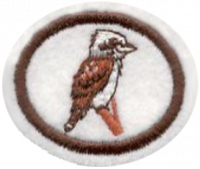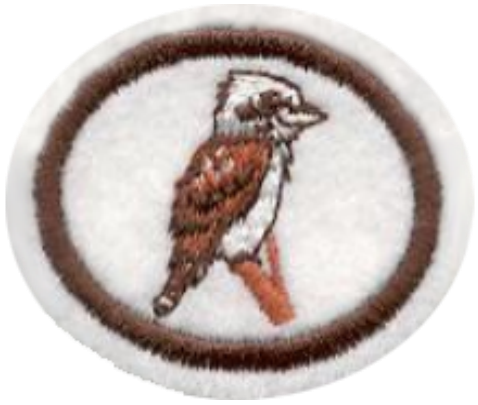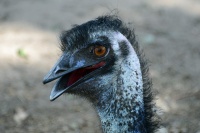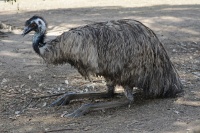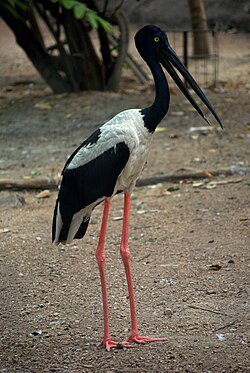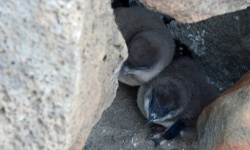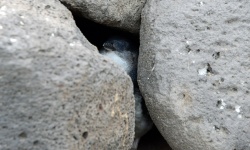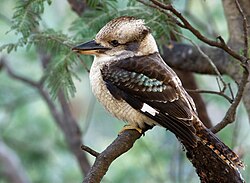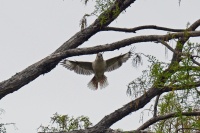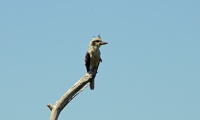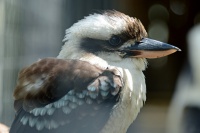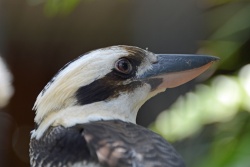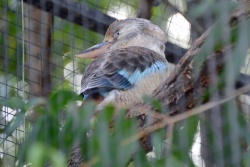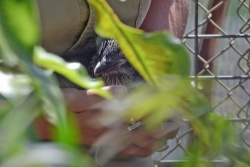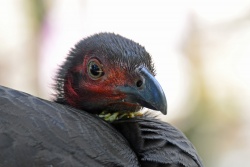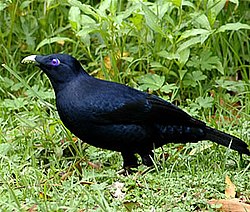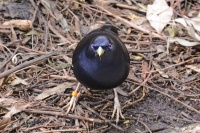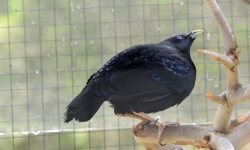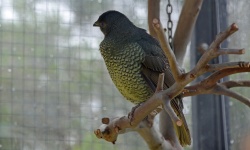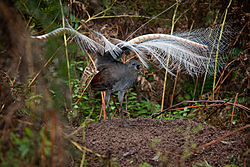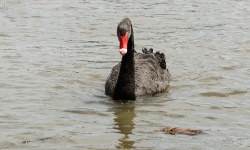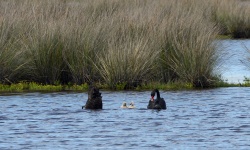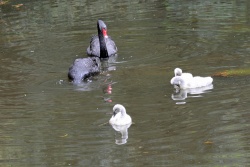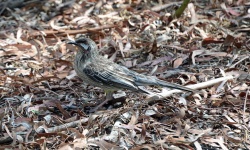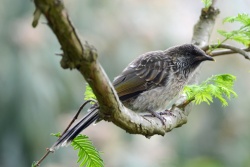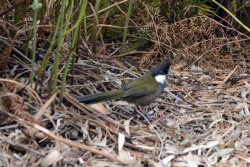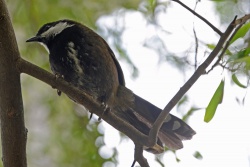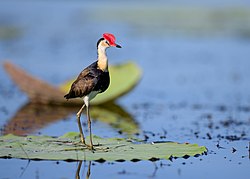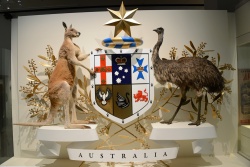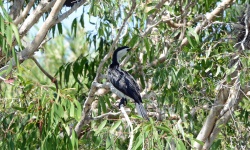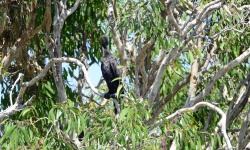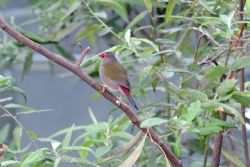Respuestas para la especialidad JA de Aves australianas
Nivel de destreza
Desconocido
Año
Desconocido
Version
04.12.2025
Autoridad de aprobación
División del Pacífico Sur
1
1a
1b
1c
1d
1e
2
Los pingüinos viven a lo largo de la costa sur de Australia y otras partes del mundo (véase el mapa). Mire las playas del océano.
3
3a
3b
Order Coraciiformes (Kingfishers and Rollers)
Family Alcedinidae (Kingfishers)
Genus Dacelo (Kookaburras)
Dacelo novaeguineae - Laughing Kookaburra Dacelo leachii - Blue-Winged Kookaburra
3c
Most species of kookaburra live in family units, mate for life, and both parents assist with incubation and feeding. In addition, the offspring help the parents hunt and care for the next generation of offspring. Now that is unusual in any species!
4
4a
Australia's Megapodes are mound-builders, making large nests from leaf litter to incubate their eggs. These include the Australian Brush-Turkey (Alectura lathami), the Malleefowl (Leipoa ocellata), and the Orange-Footed Scrub Fowl (Megapodius reinwardt).
4b
Australian Brush-Turkeys, and other megapodes, build their nests by scraping together large mounds of leaf litter. The eggs are laid in the mound and covered. Warmth is provided by the decaying vegetation, with the Brush-Turkey adjusting the temperature (which it measures by sticking its beak into the mound) by adding or removing brush as needed.
4c
The Megapodes are often also called Mound Builders or Incubator Birds.
5
5a
A bower is large structure made of grass and bright objects, used by the bower bird during courtship displays to attract a mate. They prefer blue items.
5b
Check the ranges of the various bower bird species to find one that lives in your state. If no Bower Birds live in your state (you live outside the range of the bird), consider picking an Australian state and figuring out one that lives there.
The Satin Bowerbird, perhaps the best known, is found in at least three Australian states, from Queensland to Victoria. Below are the male and female Satin Bowerbirds.
A partial list of Australian Bowerbirds by state:
- Queensland:
- Spotted Catbird (Ailuroedus melanotis)
- Green Catbird (Ailuroedus crassirostris)
- Tooth-Billed Bowerbird (Scenopoeetes dentirostris)
- Golden Bowerbird (Prionodura newtoniana)
- Regent Bowerbird (Sericulus chrysocephalus)
- Satin Bowerbird (Ptilonorhynchus violaceus)
- Spotted Bowerbird (Chlamydera maculata)
- Great Bowerbird (Chlamydera nuchalis)
- Fawn-Breasted Bowerbird (Chlamydera cerviniventris)
- New South Wales:
- Green Catbird (Ailuroedus crassirostris)
- Regent Bowerbird (Sericulus chrysocephalus)
- Satin Bowerbird (Ptilonorhynchus violaceus)
- Spotted Bowerbird (Chlamydera maculata)
- Victoria:
- Satin Bowerbird (Ptilonorhynchus violaceus)
- South Australia:
- Western Bowerbird (Chlamydera guttata)
- Western Australia:
- Western Bowerbird (Chlamydera guttata)
- Great Bowerbird (Chlamydera nuchalis)
- Northern Territory:
- Western Bowerbird (Chlamydera guttata)
- Great Bowerbird (Chlamydera nuchalis)
6
The lyrebird's name came from an ignorant mistake, perpetrated in a famous painting. The male bird has a spectacular tail, consisting of 16 highly modified feathers (two long slender lyrates at the centre of the plume, two broader medians on the outside edges and twelve filamentaries arrayed between them).
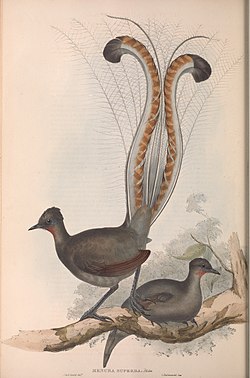 This happened when a superb lyrebird specimen (which had been taken from Australia to England during the early 19th century) was prepared for display at the British Museum by a taxidermist who had never seen a live lyrebird. The taxidermist mistakenly thought that the tail would resemble a lyre, and that the tail would be held in a similar way to that of a peacock during courtship display, and so he arranged the feathers in this way. Later, John Gould (who had also never seen a live lyrebird), painted the lyrebird from the British Museum specimen.
This happened when a superb lyrebird specimen (which had been taken from Australia to England during the early 19th century) was prepared for display at the British Museum by a taxidermist who had never seen a live lyrebird. The taxidermist mistakenly thought that the tail would resemble a lyre, and that the tail would be held in a similar way to that of a peacock during courtship display, and so he arranged the feathers in this way. Later, John Gould (who had also never seen a live lyrebird), painted the lyrebird from the British Museum specimen.
Although very beautiful, the male lyrebird's tail is not held as in John Gould's painting. Instead, the male lyrebird's tail is fanned over the lyrebird during courtship display, with the tail completely covering his head and back—as can be seen in the image below and also the image of the 10 cent coin, where the superb lyrebird's tail (in courtship display) is portrayed accurately.
A lyrebird's song is one of the more distinctive aspects of its behavioural biology. Lyrebirds sing throughout the year, but the peak of the breeding season, from June to August, is when they sing with the most intensity. During this peak they may sing for four hours of the day, almost half the hours of daylight. The song of the superb lyrebird is a mixture of seven elements of its own song and any number of other mimicked songs and noises. The lyrebird's syrinx is the most complexly-muscled of the Passerines (songbirds), giving the lyrebird extraordinary ability, unmatched in vocal repertoire and mimicry. Lyrebirds render with great fidelity the individual songs of other birds and the chatter of flocks of birds, and also mimic other animals such as koalas and dingos. The lyrebird is capable of imitating almost any sound and they have been recorded mimicking human caused sounds such as a mill whistle to a cross-cut saw, chainsaws, car engines and car alarms, fire alarms, rifle-shots, camera shutters, dogs barking, crying babies, music, and even the human voice. However, while the mimicry of human noises is widely reported, the extent to which it happens is exaggerated and the phenomenon is quite unusual.
The superb lyrebird's mimicked calls are learned from the local environment, including from other superb lyrebirds. An instructive example of this is the population of superb lyrebirds in Tasmania, which have retained the calls of species not native to Tasmania in their repertoire, but have also added some local Tasmanian endemic bird noises. It takes young birds about a year to perfect their mimicked repertoire. The female lyrebirds of both species are also mimics, and will sing on occasion but the females do so with less skill than the males. A recording of a superb lyrebird mimicking sounds of an electronic shooting game, workmen and chainsaws was added to the National Film and Sound Archive's Sounds of Australia registry in 2013.
One researcher, Sydney Curtis, has recorded flute-like lyrebird calls in the vicinity of the New England National Park. Similarly, in 1969, a park ranger, Neville Fenton, recorded a lyrebird song which resembled flute sounds in the New England National Park. After much detective work by Fenton, it was discovered that in the 1930s, a flute player living on a farm adjoining the park used to play tunes near his pet lyrebird. The lyrebird adopted the tunes into his repertoire, and retained them after release into the park. Neville Fenton forwarded a tape of his recording to Norman Robinson. Because a lyrebird is able to carry two tunes at the same time, Robinson filtered out one of the tunes and put it on the phonograph for the purposes of analysis. The song represents a modified version of two popular tunes in the 1930s: "The Keel Row" and "Mosquito's Dance". Musicologist David Rothenberg has endorsed this information.
7
7a
Wedge-tailed Eagles use the updrafts of thermals or hillslopes to rise effortlessly rarely needing to flap their huge wings. They soar very high in great circles. Wingspan typically is between 182 and 232 cm (6 ft 0 in and 7 ft 7 in) with the verified record being 284 cm (9 ft 4 in). This is similar to the bald eagle.
7b
The Wedge-tailed Eagle have sophisticated binocular vision which enables them to accurately assess distances and pinpoint their prey. Their eyes also are equipped with bony rings which can squeeze and elongate the eyeball. This has the same effect as a telephoto lens on a camera. It enlarges the image seen by the bird. This is very unusual.
7c
According to this list, the fastest bird of prey is the Peregrine Falcon with a maxium dive speed of 389 km/h or 242 mph! Now that is fast!
7d
8
9
9a
Wattlebirds are honeyeaters characterized by their wattles, bare fleshy appendages, usually wrinkled and often brightly coloured, hanging from the cheeks, neck or throat, and presumably serving for display. The exception is the Little Wattlebird, which lacks wattles. A few other types of birds also have wattles, turkeys being the most well known example.
Below, on the left, is the Red Wattlebird (Anthochaera carunculata), with very visible red wattles. On the right is the Little Wattlebird (Anthochaera chrysoptera), which, as noted above, lacks wattles. Other wattlebirds include the Yellow Wattlebird and the Western Wattlebird.
9b
The Catbird had a cat like cry.
9c
The butcher birds are insect eaters for the most part, but will also feed on small lizards and other vertebrates. They get their name from their habit of impaling captured prey on a thorn, tree fork, or crevice. This "larder" is used to support the victim while it is being eaten, to store prey for later consumption, or to attract mates. The shrikes are sometimes called butcher birds as well and exhibit similar behaviour.
So the name comes from the fact they essentially butcher their meals.
9d
The bird has a long drawn out call - a long note, followed by a "whip crack" (which is the source of the common name) and some follow on notes - is one of the most distinctive sounds of the Australian bush. The call is usually a duet between the male and female, the male producing the long note and whip crack and female the following notes. Calls are most frequent in the early morning, though do occur through the day with small peaks at noon and sunset. Though male calls are consistent across the species range, a high degree of variation in female calls has been reported.
A sound file is available here [1]
The Eastern Whipbird (Psophodes olivaceus)
10
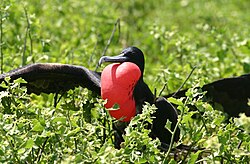 Both sexes have a patch of red skin at the throat that is the gular sac; in male great frigatebirds this is inflated in order to attract a mate. Groups of males sit in bushes and trees and force air into their sac, causing it to inflate over a period of 20 minutes into a startling red balloon. As females fly overhead the males waggle their heads from side to side, shake their wings and call.
Both sexes have a patch of red skin at the throat that is the gular sac; in male great frigatebirds this is inflated in order to attract a mate. Groups of males sit in bushes and trees and force air into their sac, causing it to inflate over a period of 20 minutes into a startling red balloon. As females fly overhead the males waggle their heads from side to side, shake their wings and call.
11
12
| Area | Coat of Arms Birds | Official Bird |
|---|---|---|
| National | Emu support, with Piping Shrike and Black Swan on shield | Emu |
| New South Wales | No birds | Kookaburra |
| Victoria | No birds | Helmeted Honeyeater |
| Queensland | Brolga | Brolga |
| Western Australia | Black Swan | Black Swan |
| Tasmania | none | none |
| Australia Capital Territory | Australian black swan, representing Aborigines, and European white mute swan, representing white settlers. | Gang-gang Cockatoo |
| Northern Territory | Wedge-tailed Eagle | Wedge-tailed Eagle |
More information about the Australian state flags and emblems can be found here. [2]
13
Brolgas are well known for their ritualised, intricate mating dances. The performance begins with a bird picking up some grass and tossing it into the air before catching it in its bill. The bird then jumps a metre (yard) into the air with outstretched wings and continues by stretching its neck, bowing, strutting around, calling and bobbing its head up and down. Sometimes just one brolga dances for its mate; often they dance in pairs; and sometimes a whole group of about a dozen dance together, lining up roughly opposite each other before they start.
14
Brood parasites lay their eggs other bird's nest. Most species of Cuckoo's get other birds to do the incubation for them.
15
All 40 species around the world are fish-eaters, dining on small eels, fish, and even water snakes. They dive from the surface, though many species make a characteristic half-jump as they dive, presumably to give themselves a more streamlined entry into the water.
Under water they propel themselves with their feet, though some also propel themselves with their wings. Some cormorant species have been tracked diving to depths of as much as 45 metres.
Cormorants have less preening oil than many other waterbirds, so their feathers can become waterlogged. They are often seen drying their feathers with wings outspread after several dives.
Below are two of Australia's cormorants, the Little Pied Cormorant on the left, and the Little Black Cormorant on the right.
16
This website has a good list to work with in answering this requirement. http://ozanimals.com/wildlife/Bird/Finches.html
Another list is available here [3] Australian finches are commony kept and bred as pets.
To determine where you would look for your favourite consider the geographic area and type of habitat they prefer.
Red-Browed Finch
